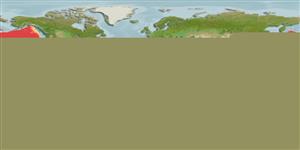>
Eupercaria/misc (Various families in series Eupercaria) >
Callanthiidae (Splendid perches)
Etymology: Grammatonotus: Greek, gramma, atos = signal, mark + Greek, noton = back (Ref. 45335).
Environment: milieu / climate zone / depth range / distribution range
Ecologie
marien; diepte 300 - 500 m (Ref. 58302). Deep-water
Western Pacific: southern Japan (Ref. 27116). Reported from the Hawaiian Islands (Ref. 58302).
Grootte / Gewicht / Leeftijd
Maturity: Lm ? range ? - ? cm
Levenscyclus en paargedrag
Maturiteit | Voortplanting | Paaien | Eieren | Fecunditeit | Larven
Anderson, W.D. Jr., B.D. Greene and L.A. Rocha, 2016. Grammatonotus brianne, a new callanthiid fish from Philippine waters, with short accounts of two other Grammatonotus from the Coral Triangle. Zootaxa 4173(3):289-295. (Ref. 111873)
Status op de Rode Lijst van het IUCN (Ref. 130435: Version 2024-2)
Gevaar voor de mens
Harmless
Gebruik door de mens
Tools
Speciale rapporten
Download XML
Internetbronnen
Estimates based on models
Preferred temperature (Ref.
123201): 8.7 - 16.2, mean 11.2 °C (based on 27 cells).
Fylogenetische diversiteitsindex (Ref.
82804): PD
50 = 0.5039 [Uniqueness, from 0.5 = low to 2.0 = high].
Bayesian length-weight: a=0.00389 (0.00180 - 0.00842), b=3.12 (2.94 - 3.30), in cm total length, based on all LWR estimates for this body shape (Ref.
93245).
Trofisch niveau (Ref.
69278): 3.3 ±0.4 se; based on size and trophs of closest relatives
Fishing Vulnerability (Ref.
59153): Low vulnerability (10 of 100).
